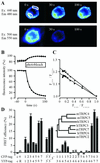Subunit composition of mammalian transient receptor potential channels in living cells
- PMID: 12032305
- PMCID: PMC124253
- DOI: 10.1073/pnas.102596199
Subunit composition of mammalian transient receptor potential channels in living cells
Abstract
Hormones, neurotransmitters, and growth factors give rise to calcium entry via receptor-activated cation channels that are activated downstream of phospholipase C activity. Members of the transient receptor potential channel (TRPC) family have been characterized as molecular substrates mediating receptor-activated cation influx. TRPC channels are assumed to be composed of multiple TRPC proteins. However, the cellular principles governing the assembly of TRPC proteins into homo- or heteromeric ion channels still remain elusive. By pursuing four independent experimental approaches--i.e., subcellular cotrafficking of TRPC subunits, differential functional suppression by dominant-negative subunits, fluorescence resonance energy transfer between labeled TRPC subunits, and coimmunoprecipitation--we investigate the combinatorial rules of TRPC assembly. Our data show that (i) TRPC2 does not interact with any known TRPC protein and (ii) TRPC1 has the ability to form channel complexes together with TRPC4 and TRPC5. (iii) All other TRPCs exclusively assemble into homo- or heterotetramers within the confines of TRPC subfamilies--e.g., TRPC4/5 or TRPC3/6/7. The principles of TRPC channel formation offer the conceptual framework to assess the physiological role of distinct TRPC proteins in living cells.
Figures




References
Publication types
MeSH terms
Substances
LinkOut - more resources
Full Text Sources
Other Literature Sources
Molecular Biology Databases
Research Materials

